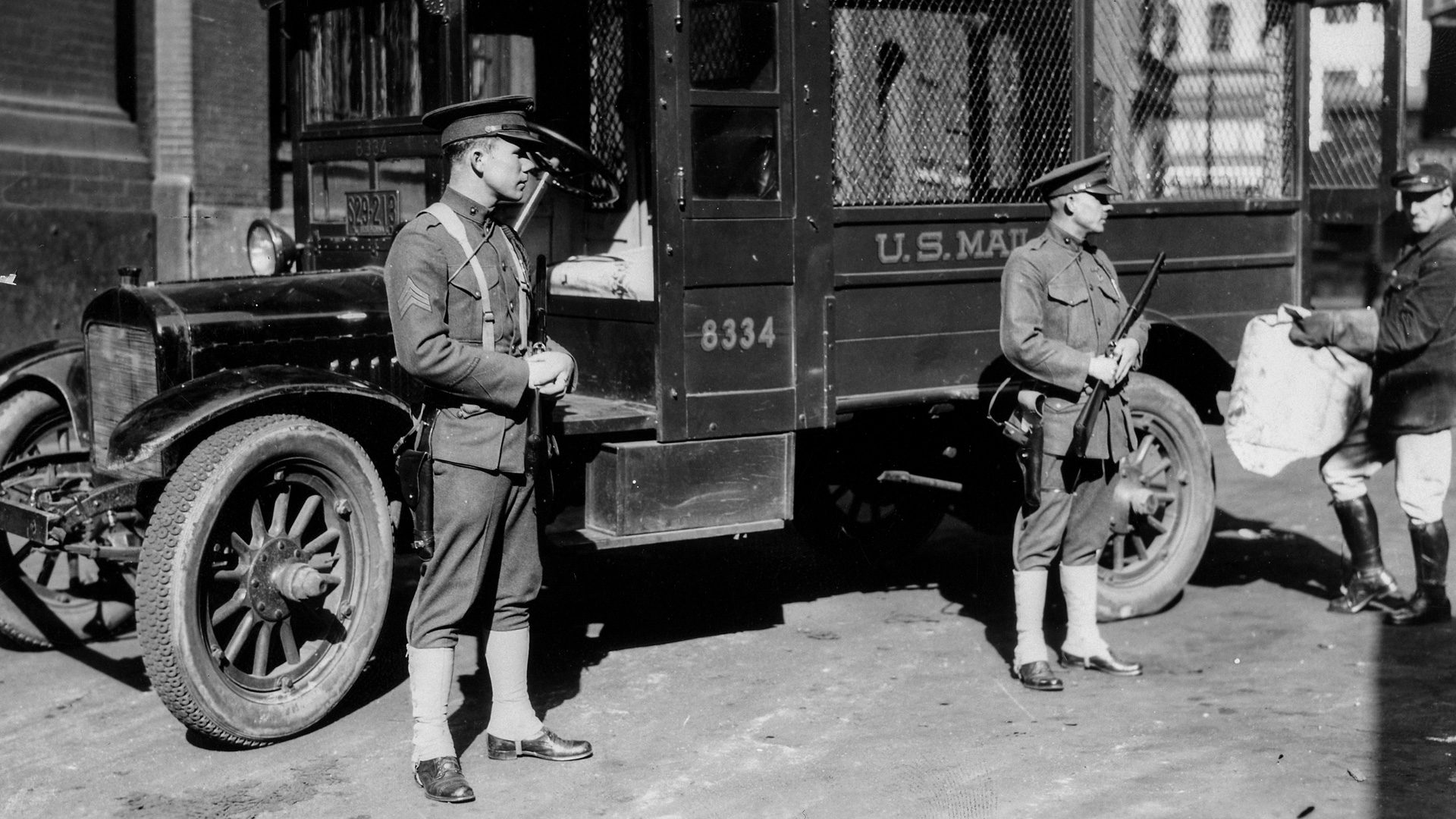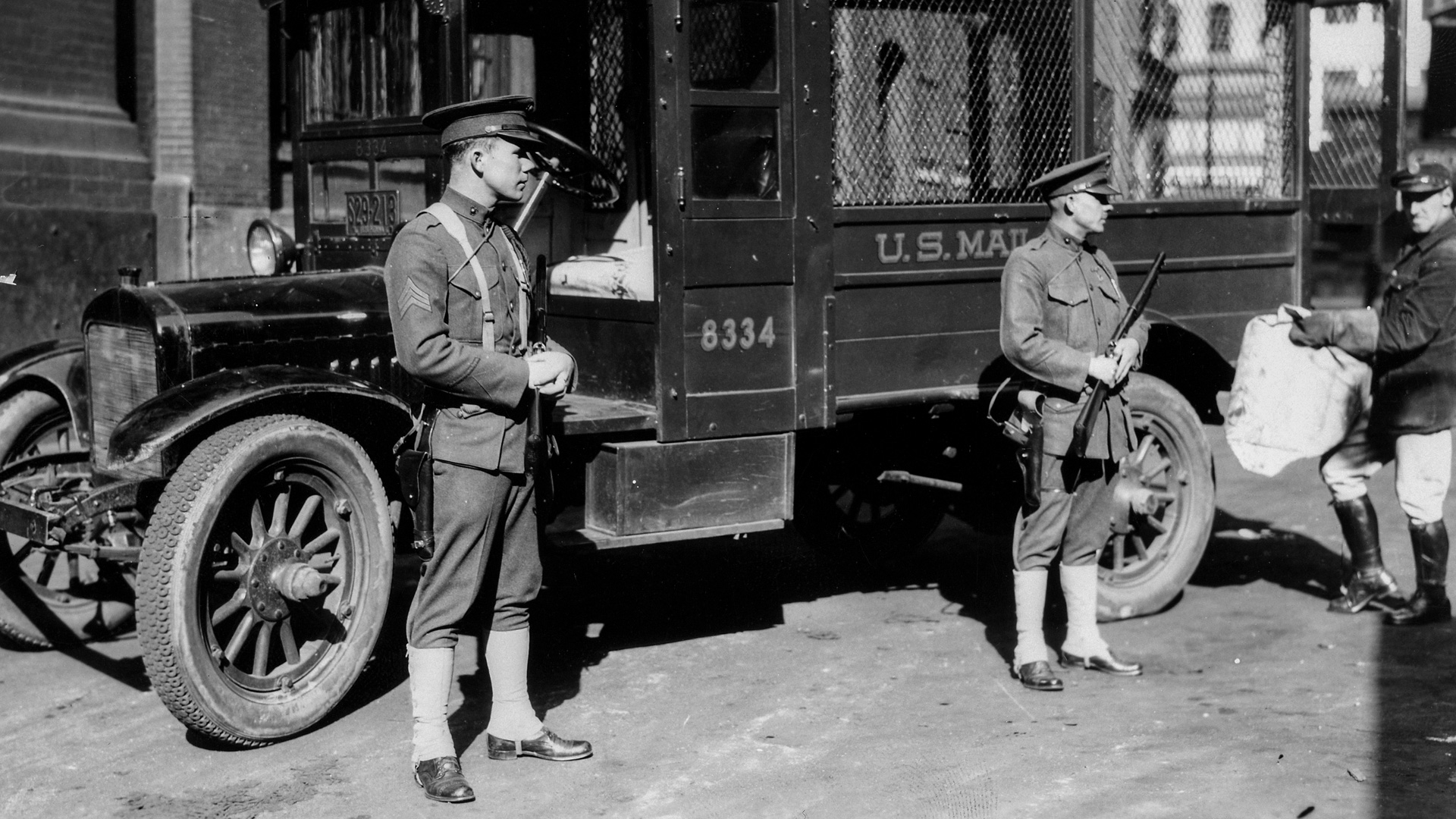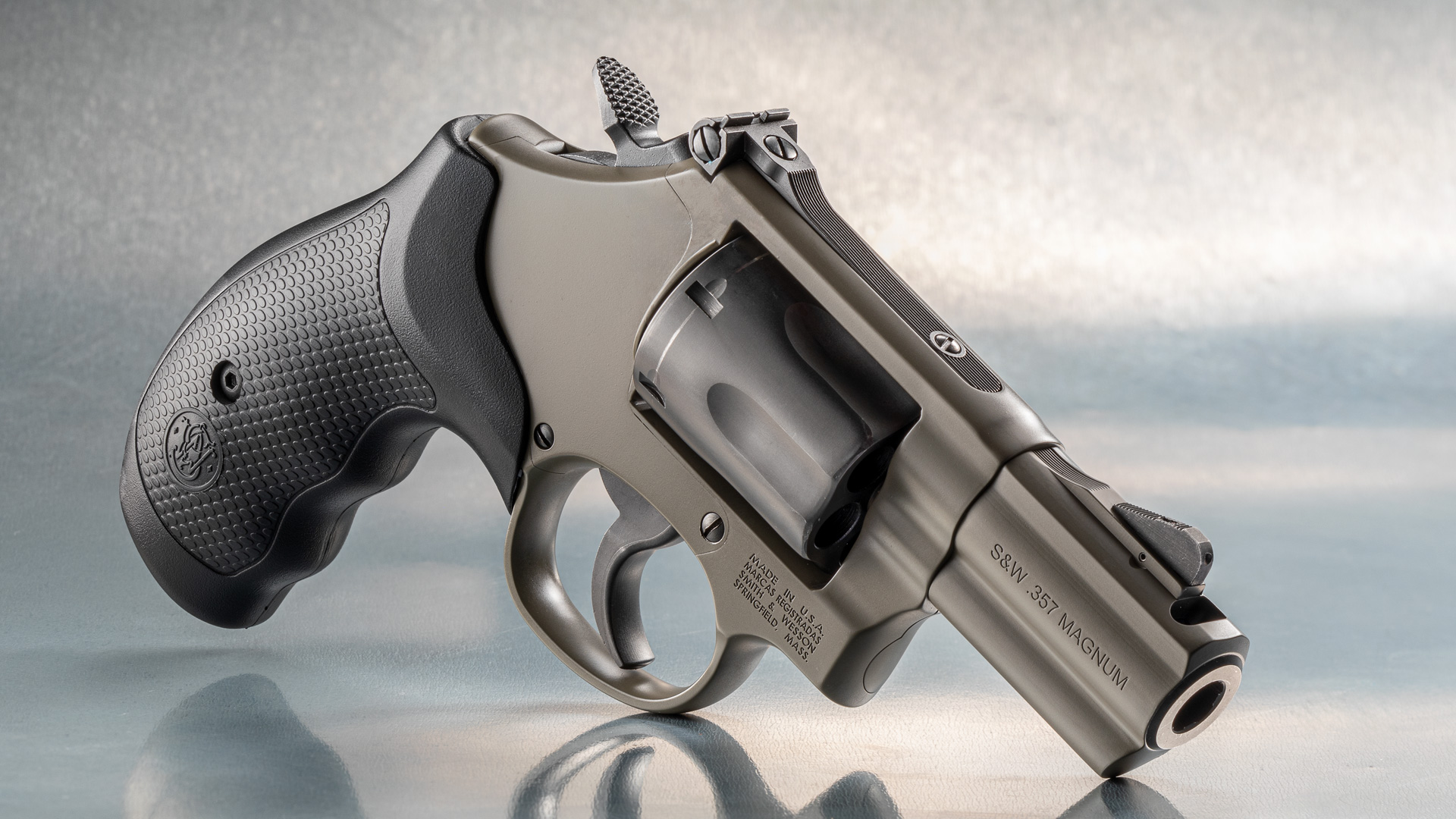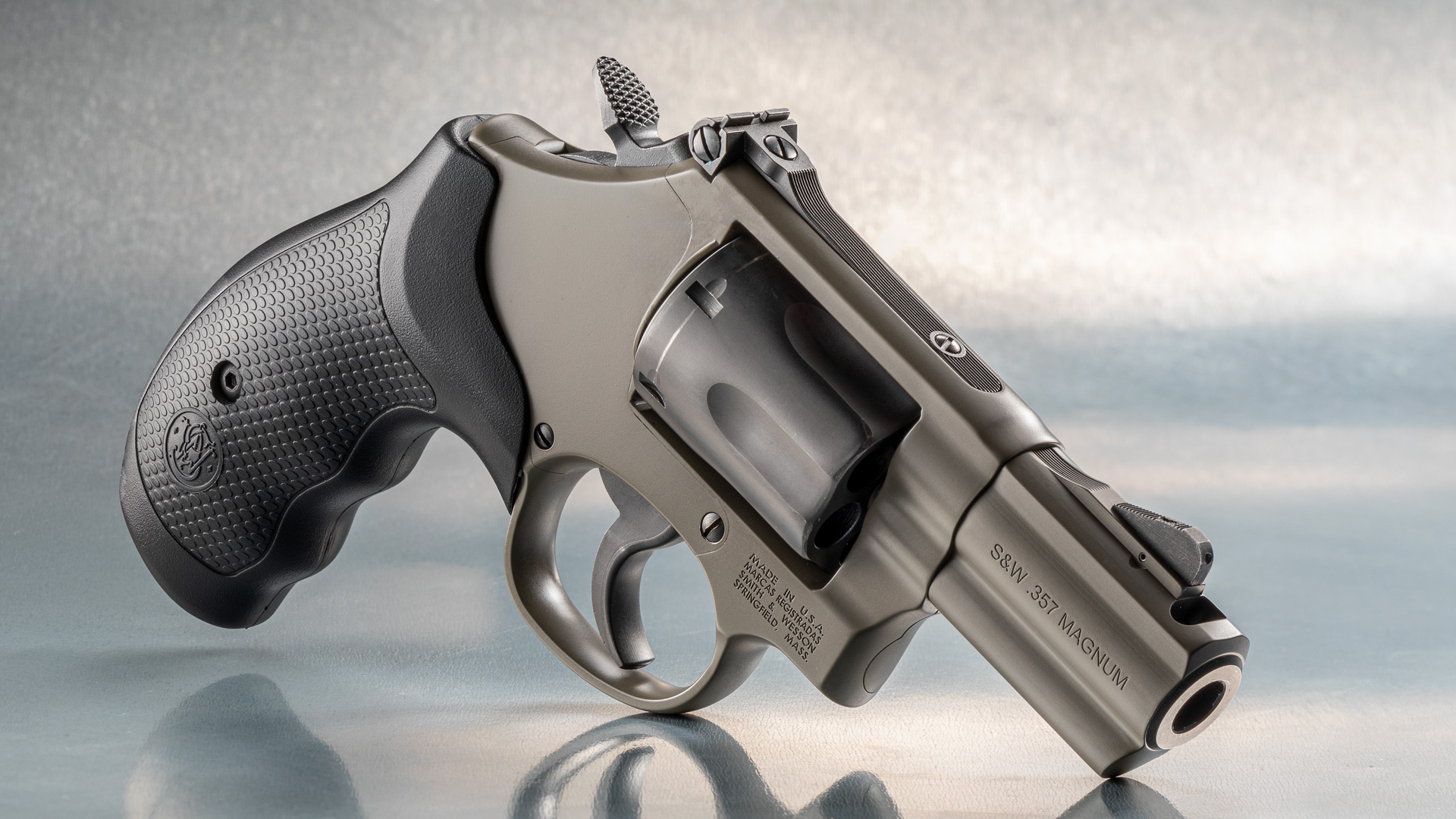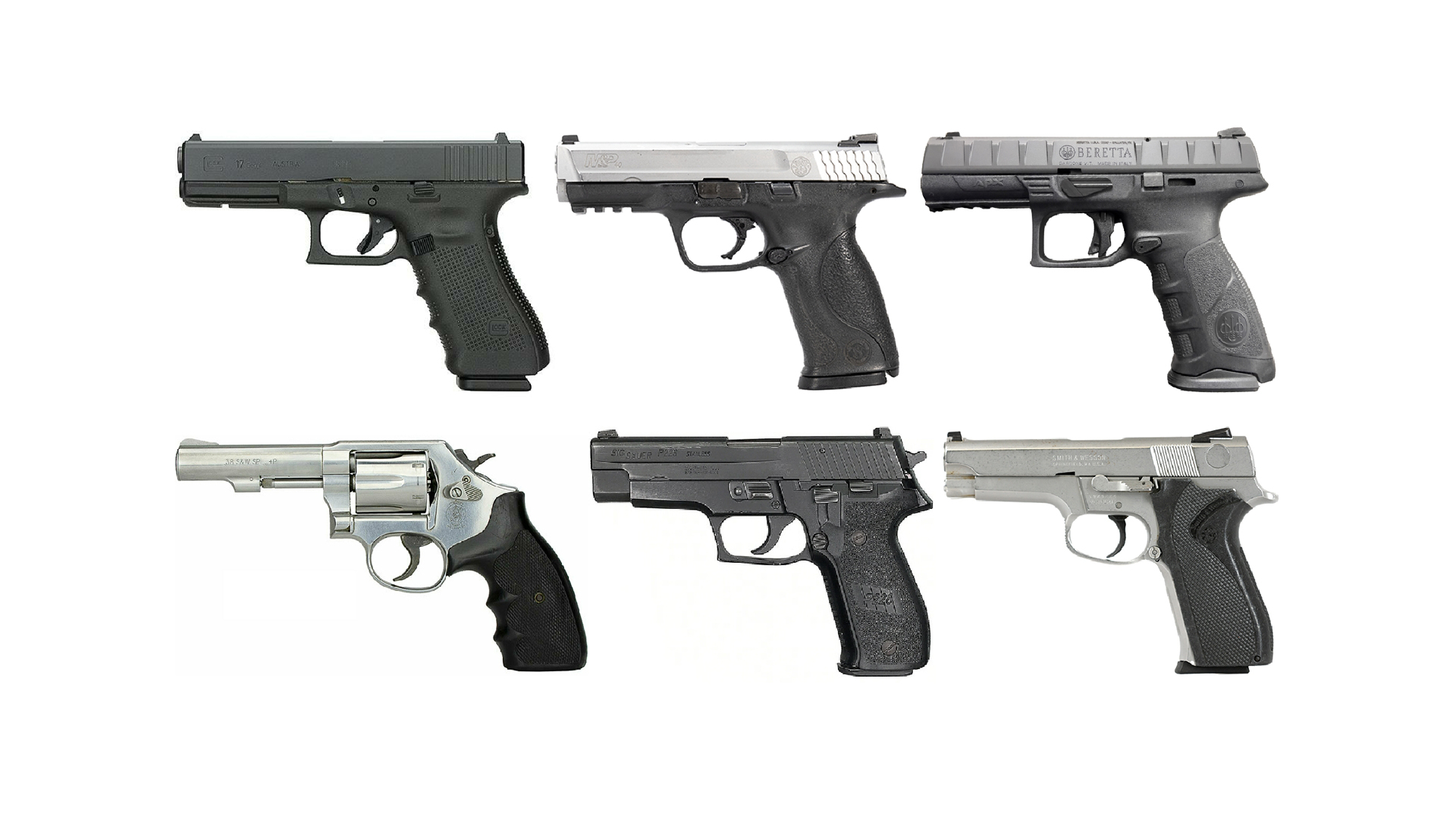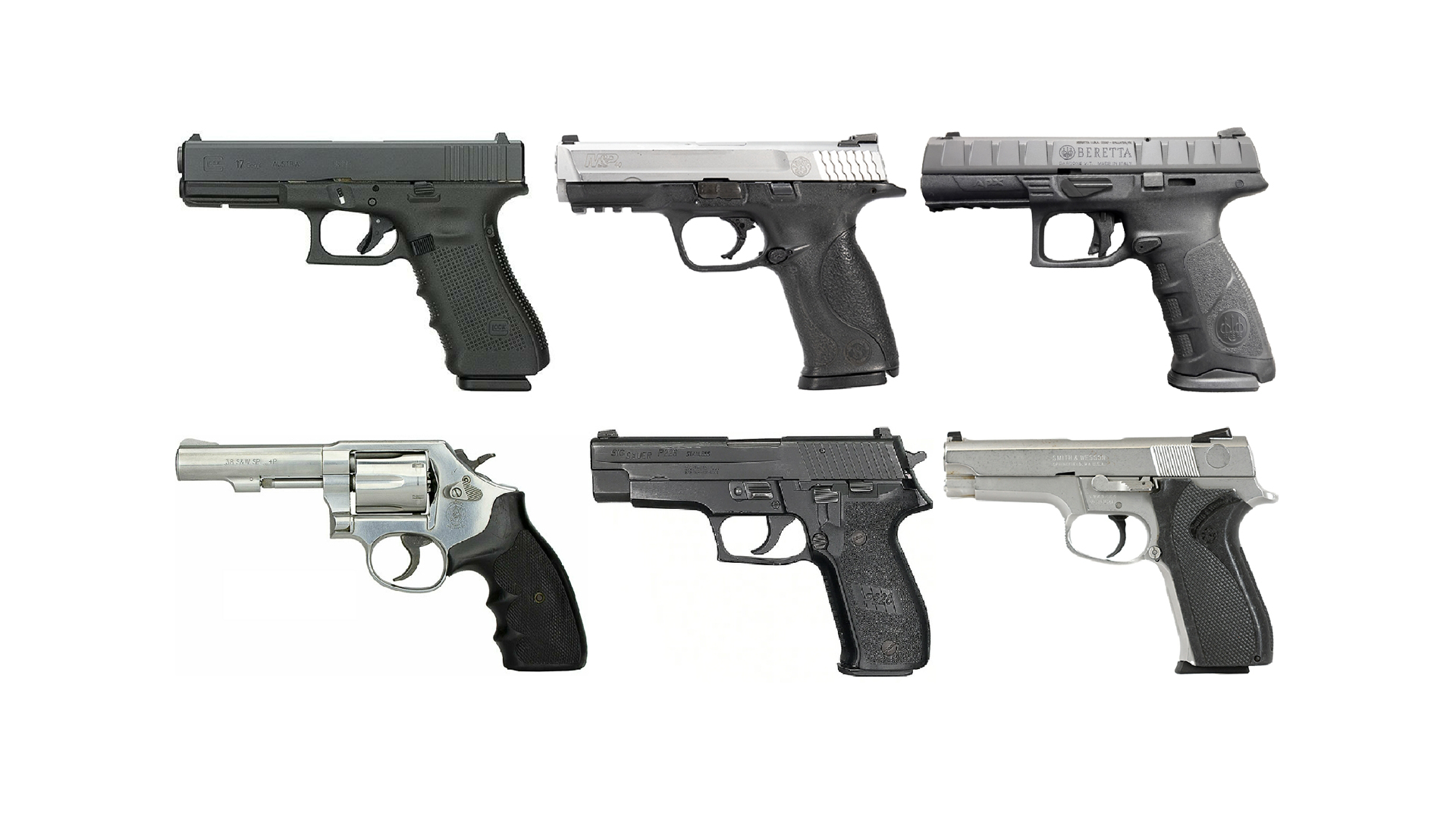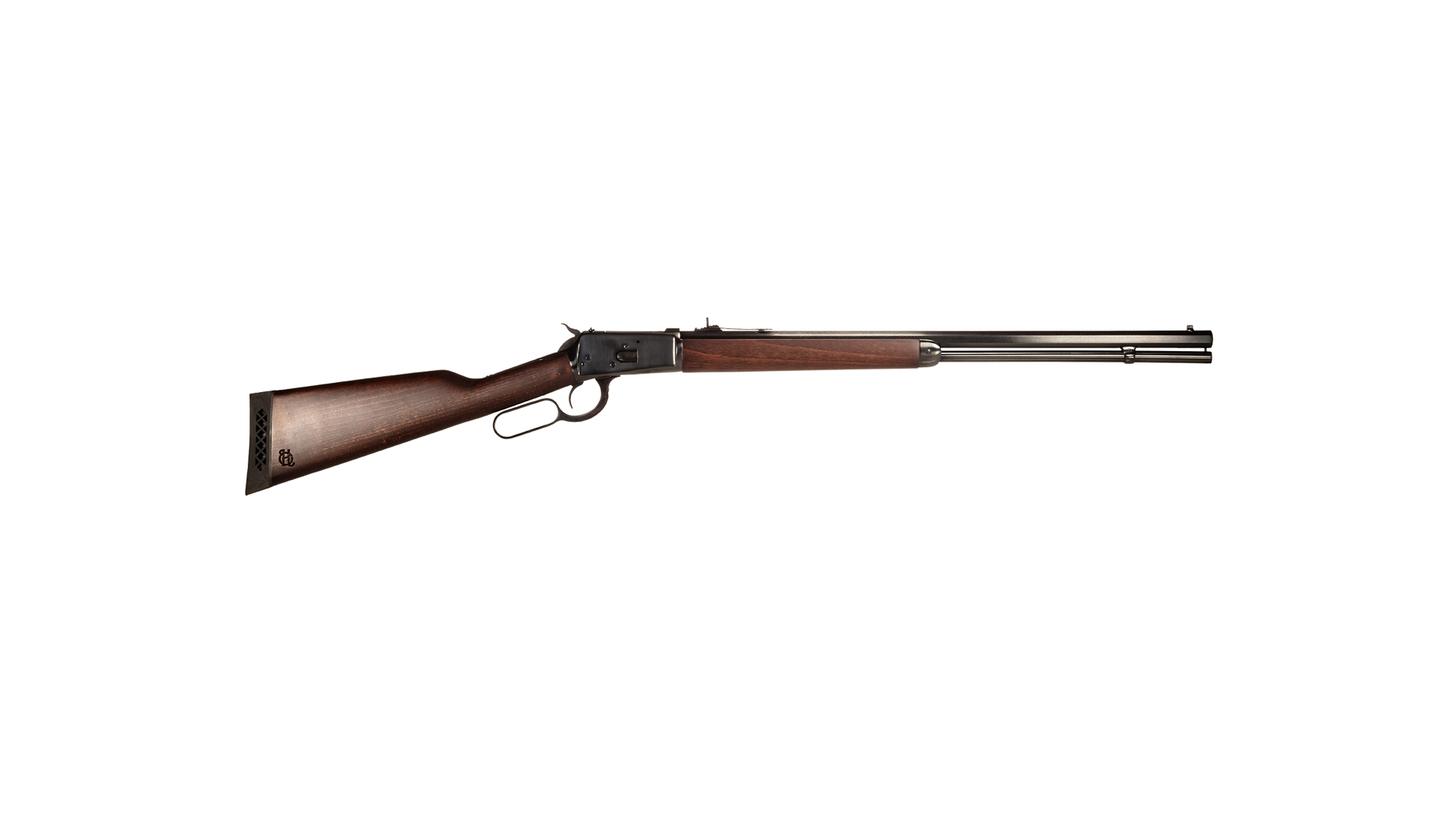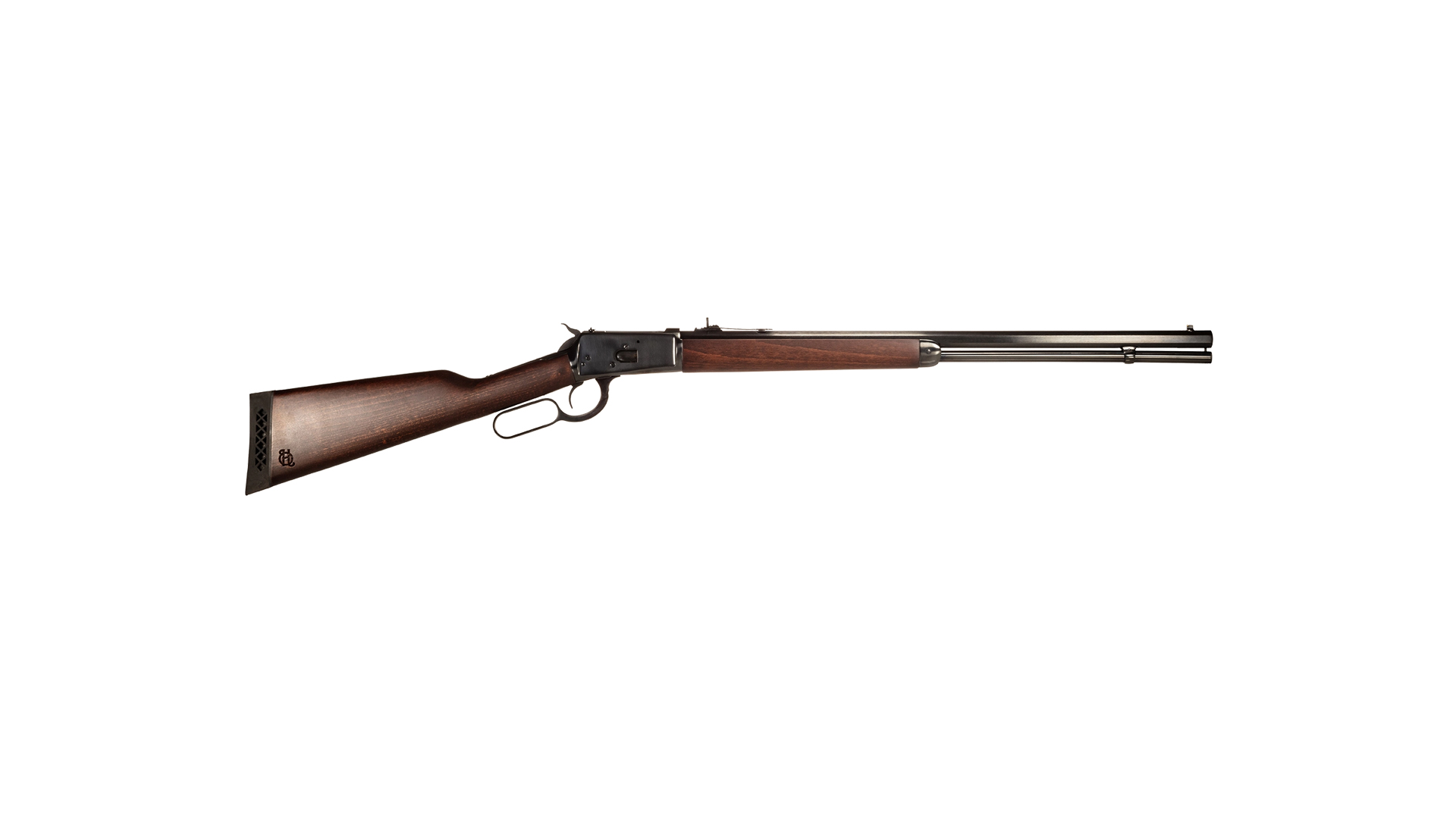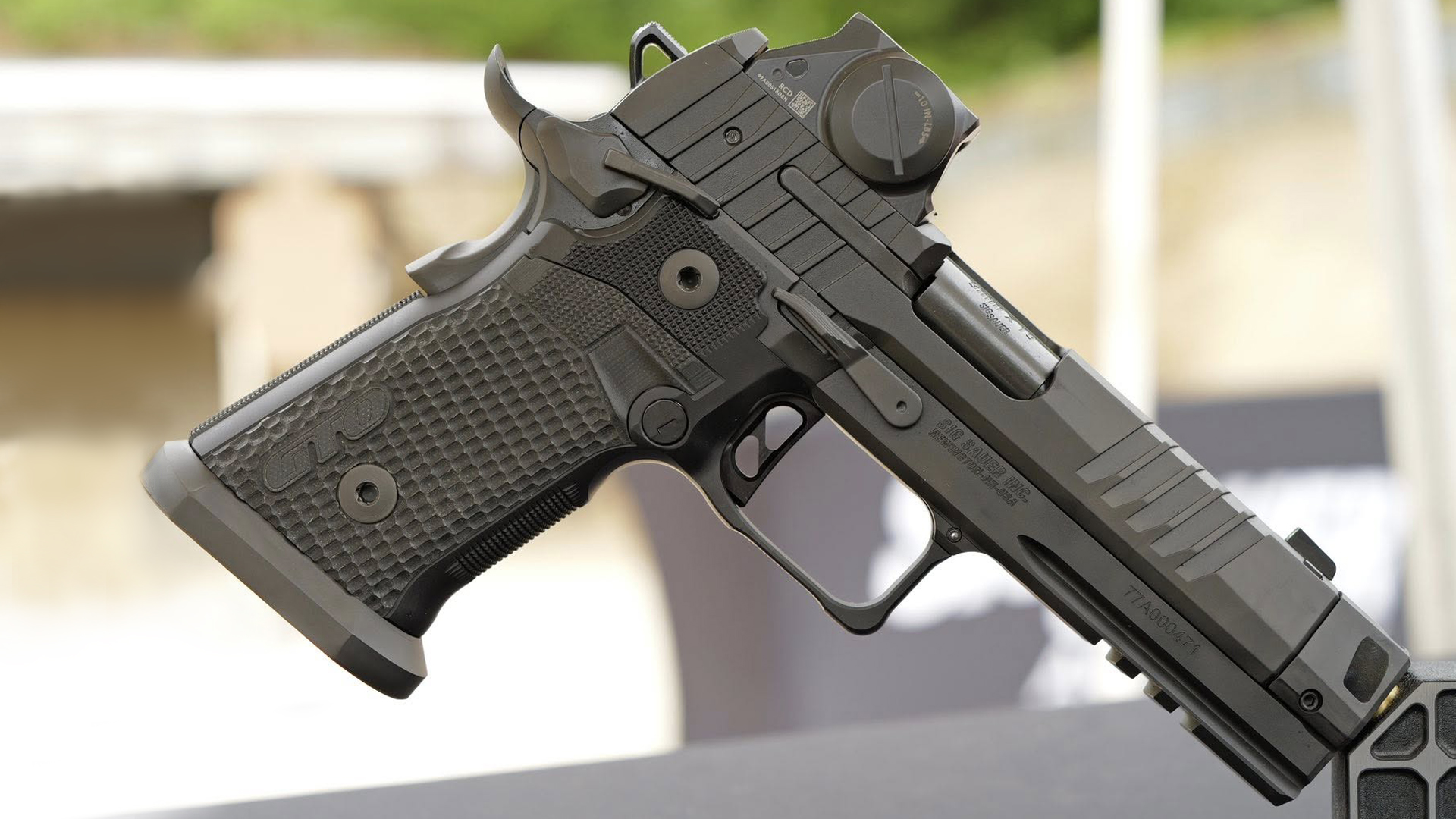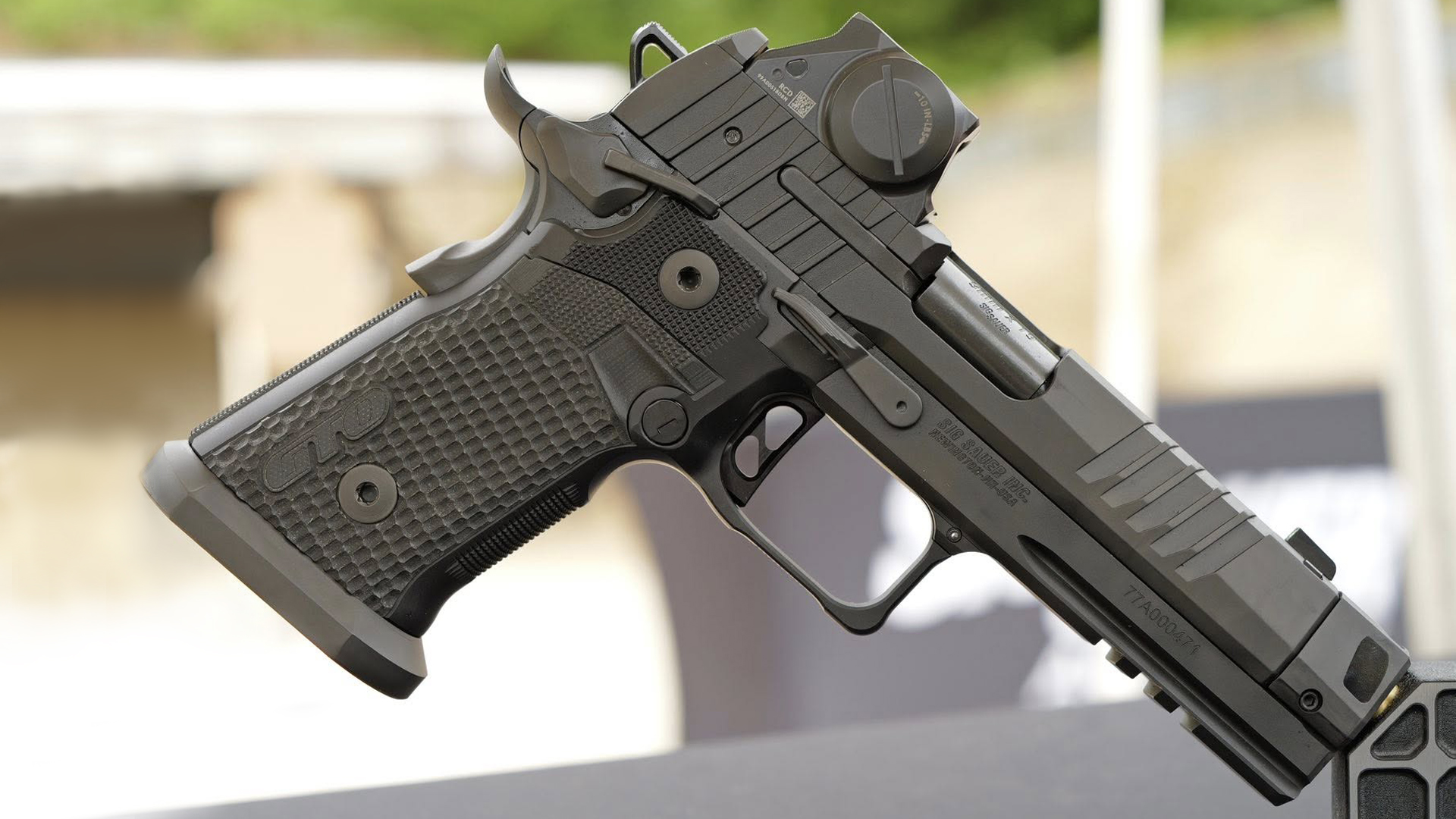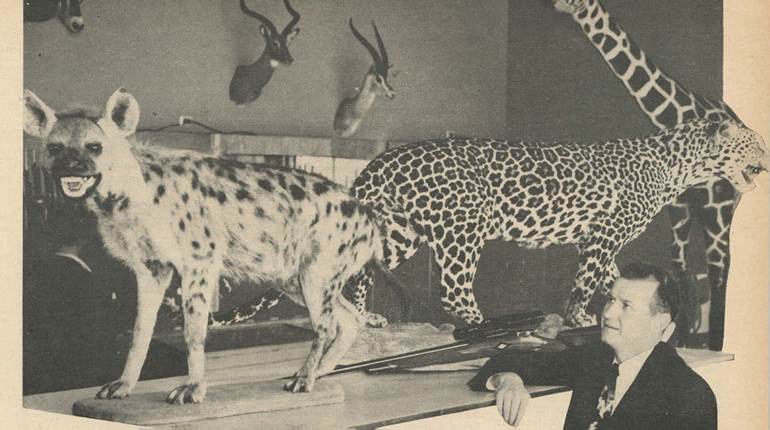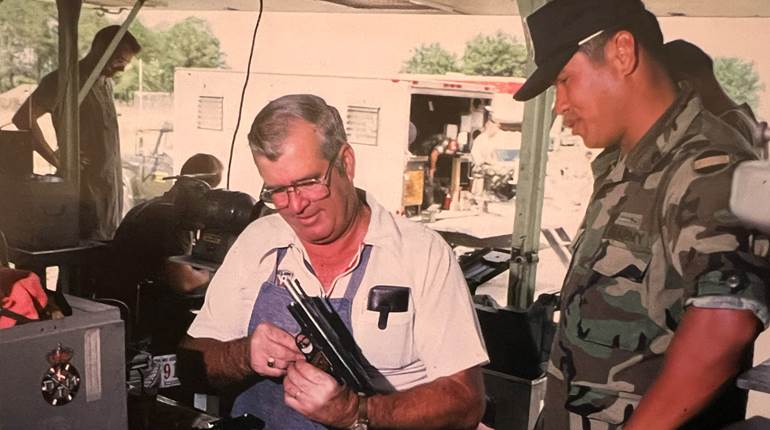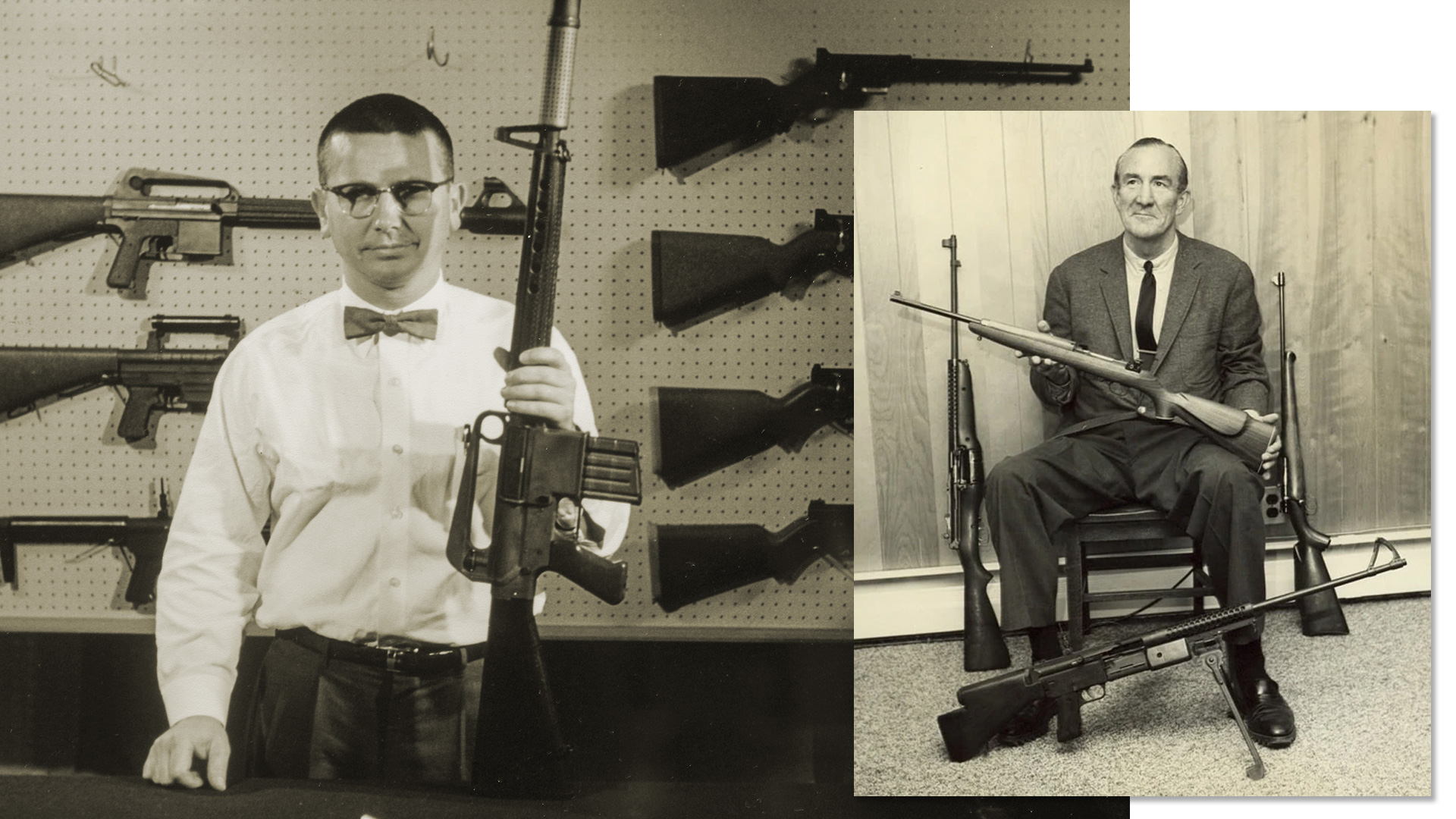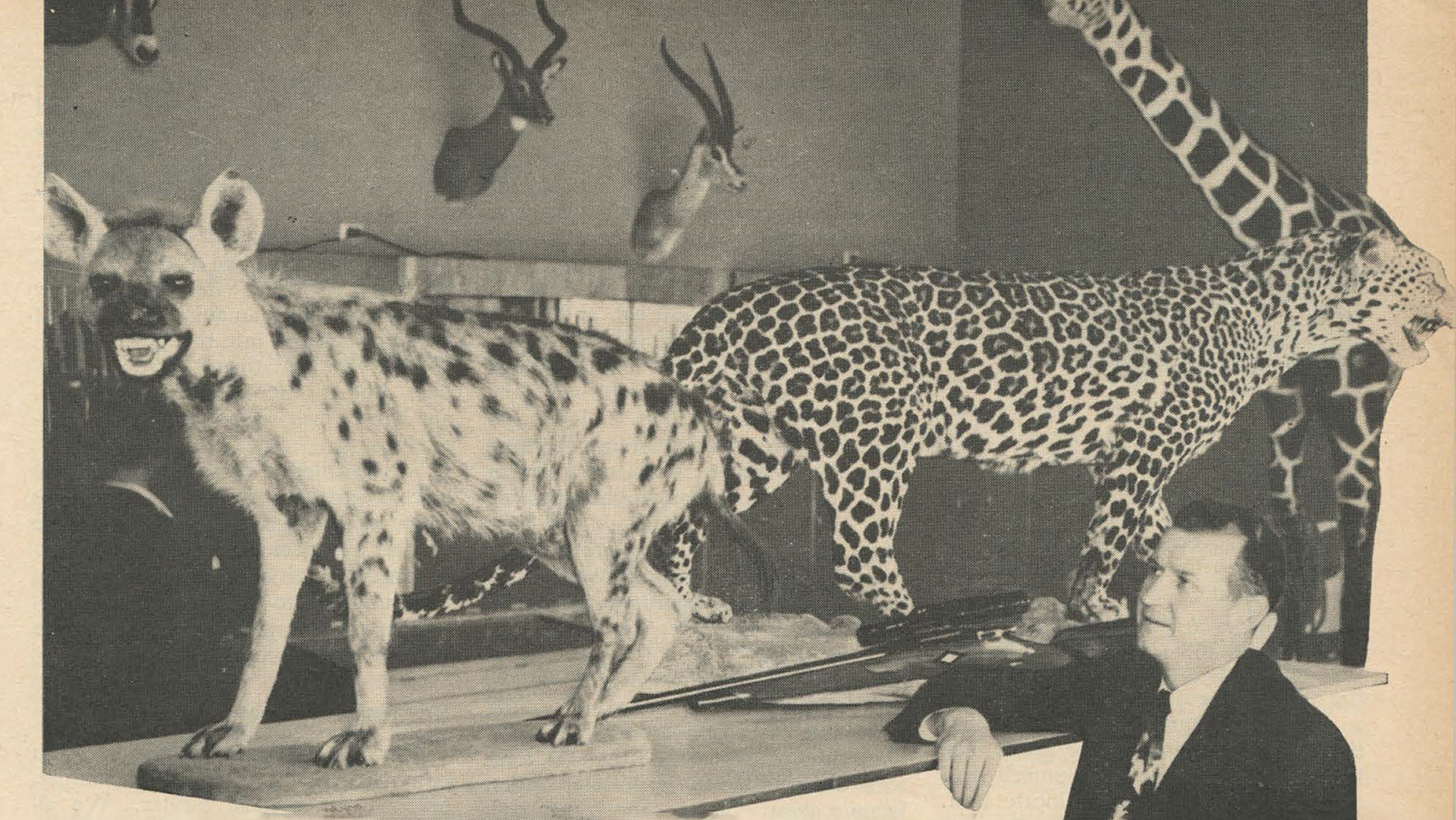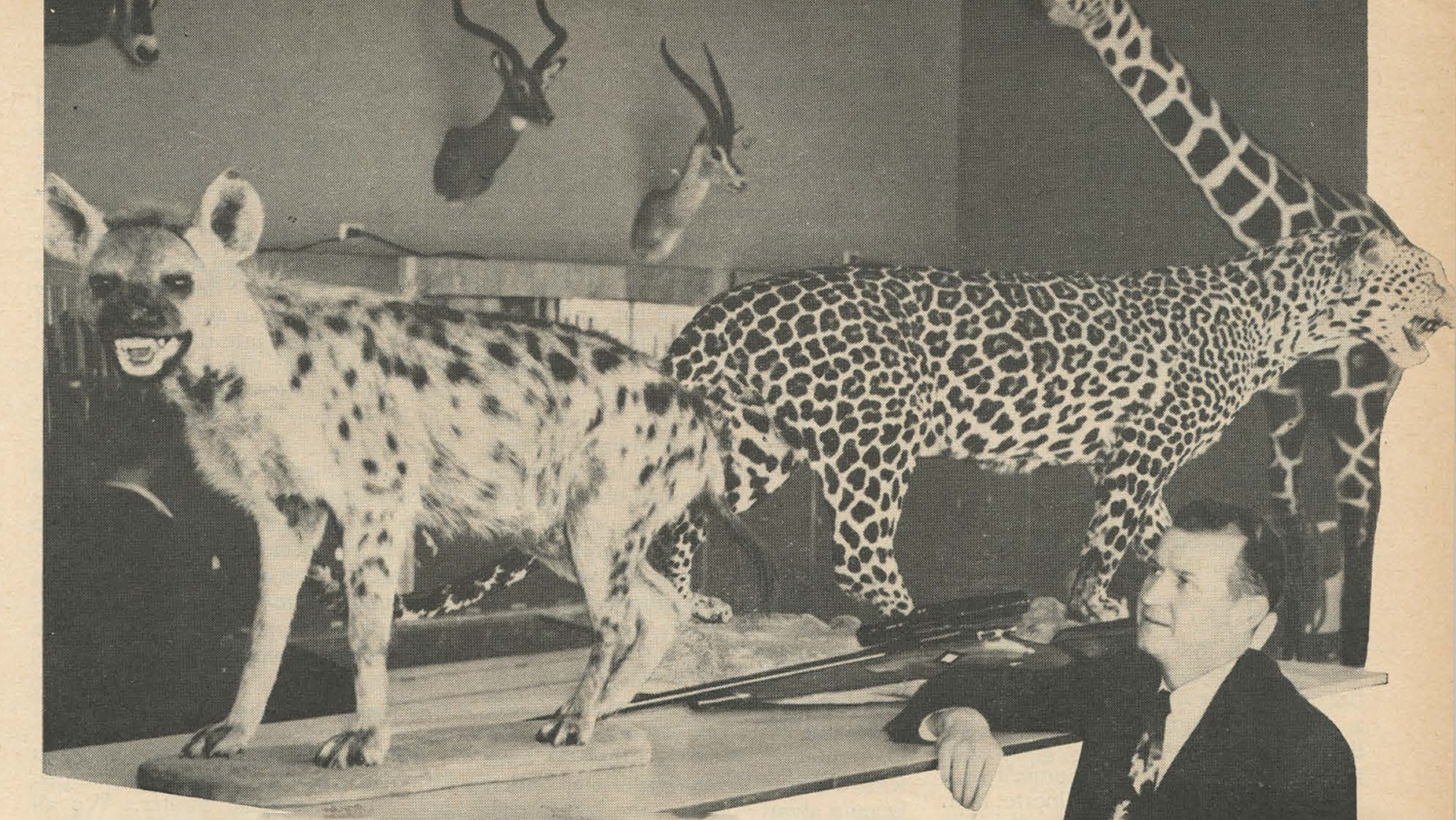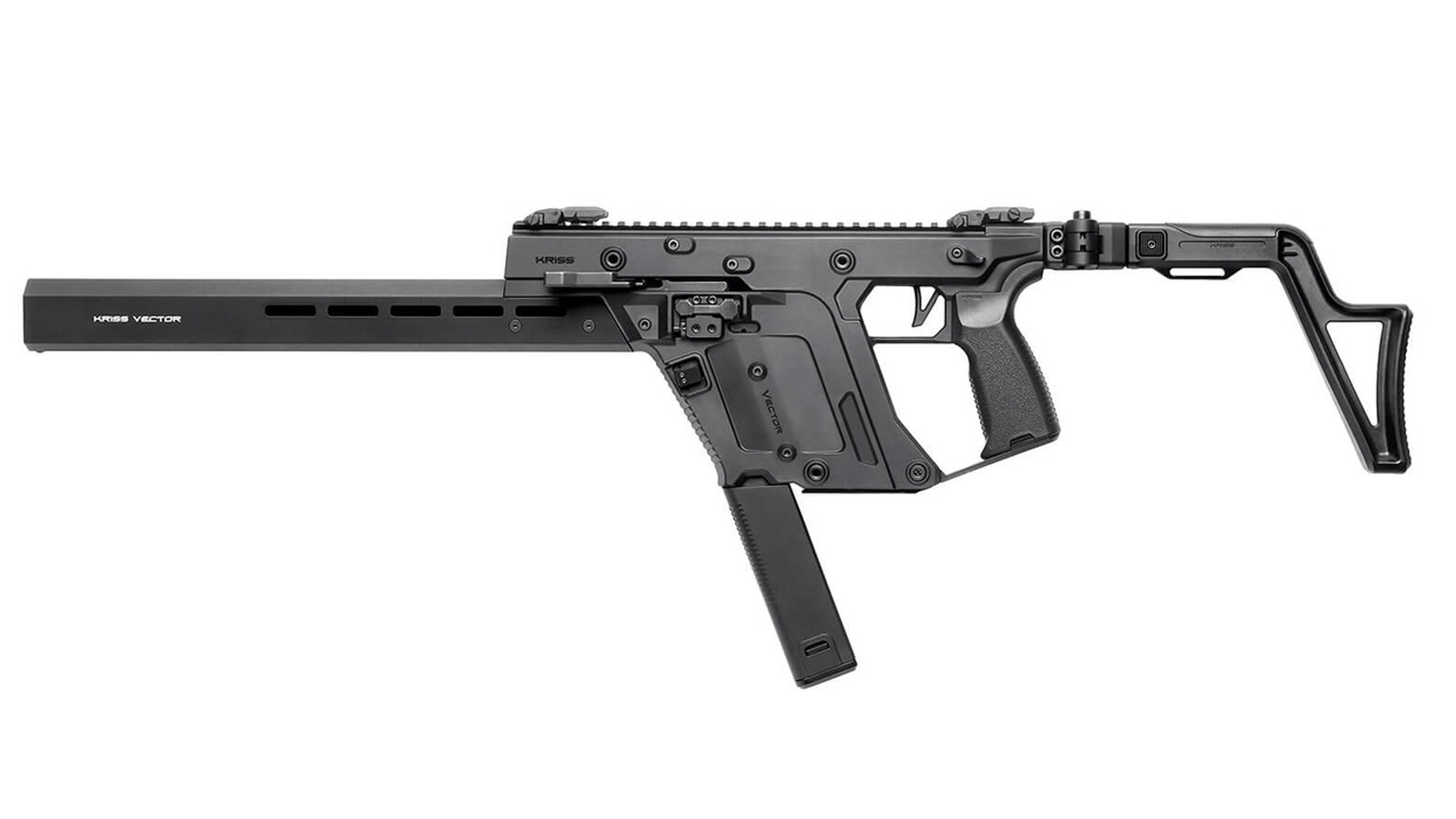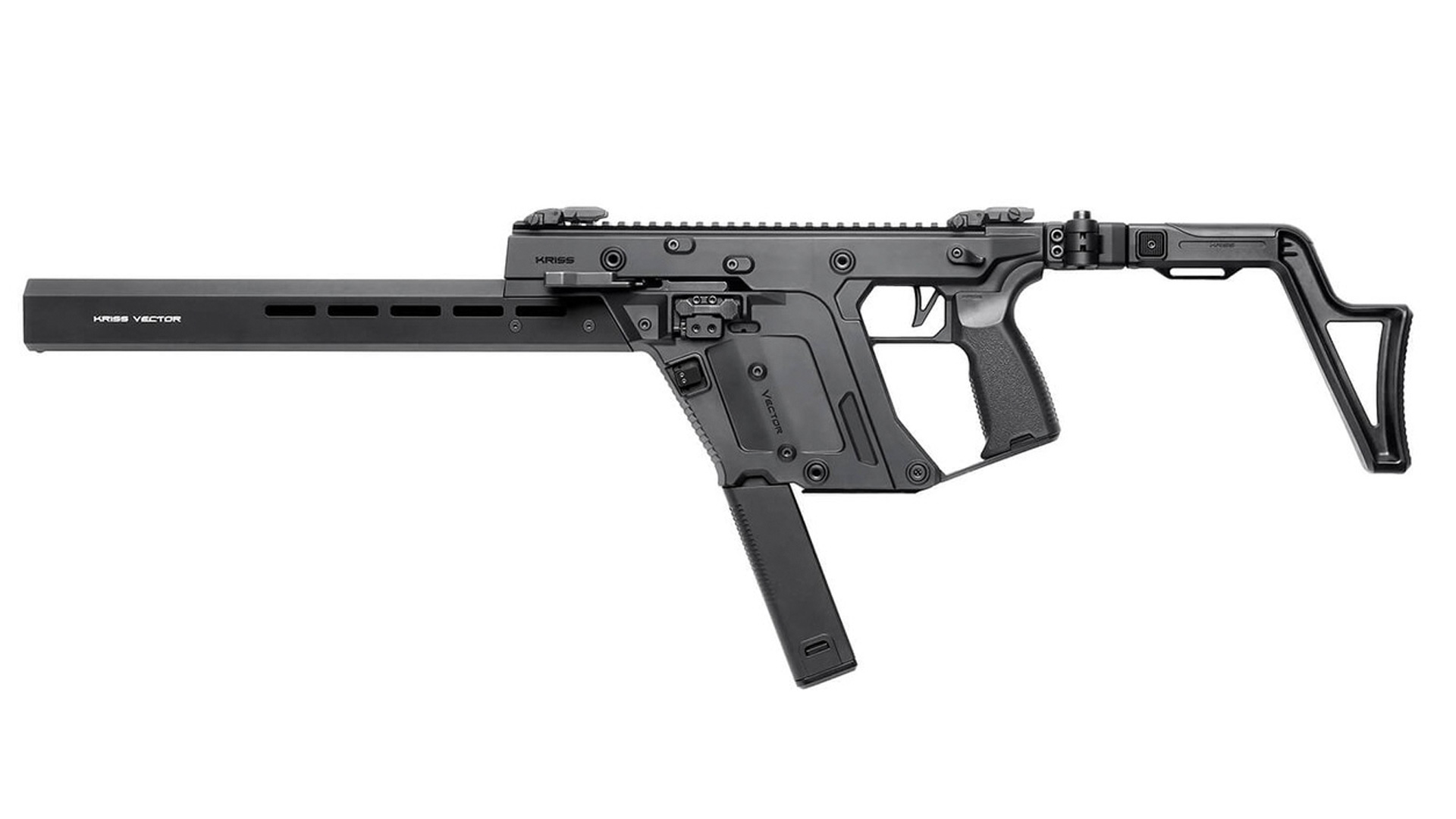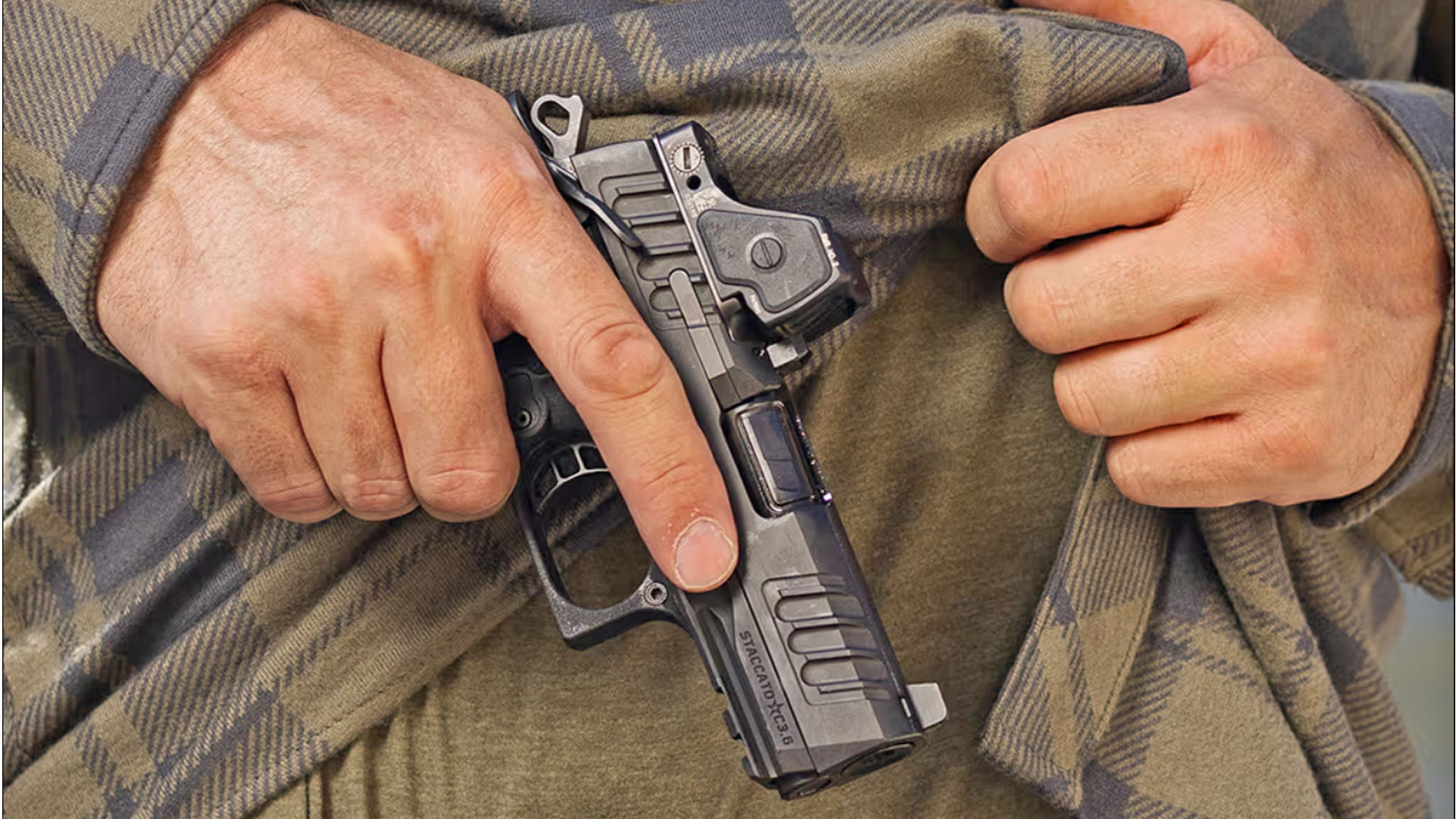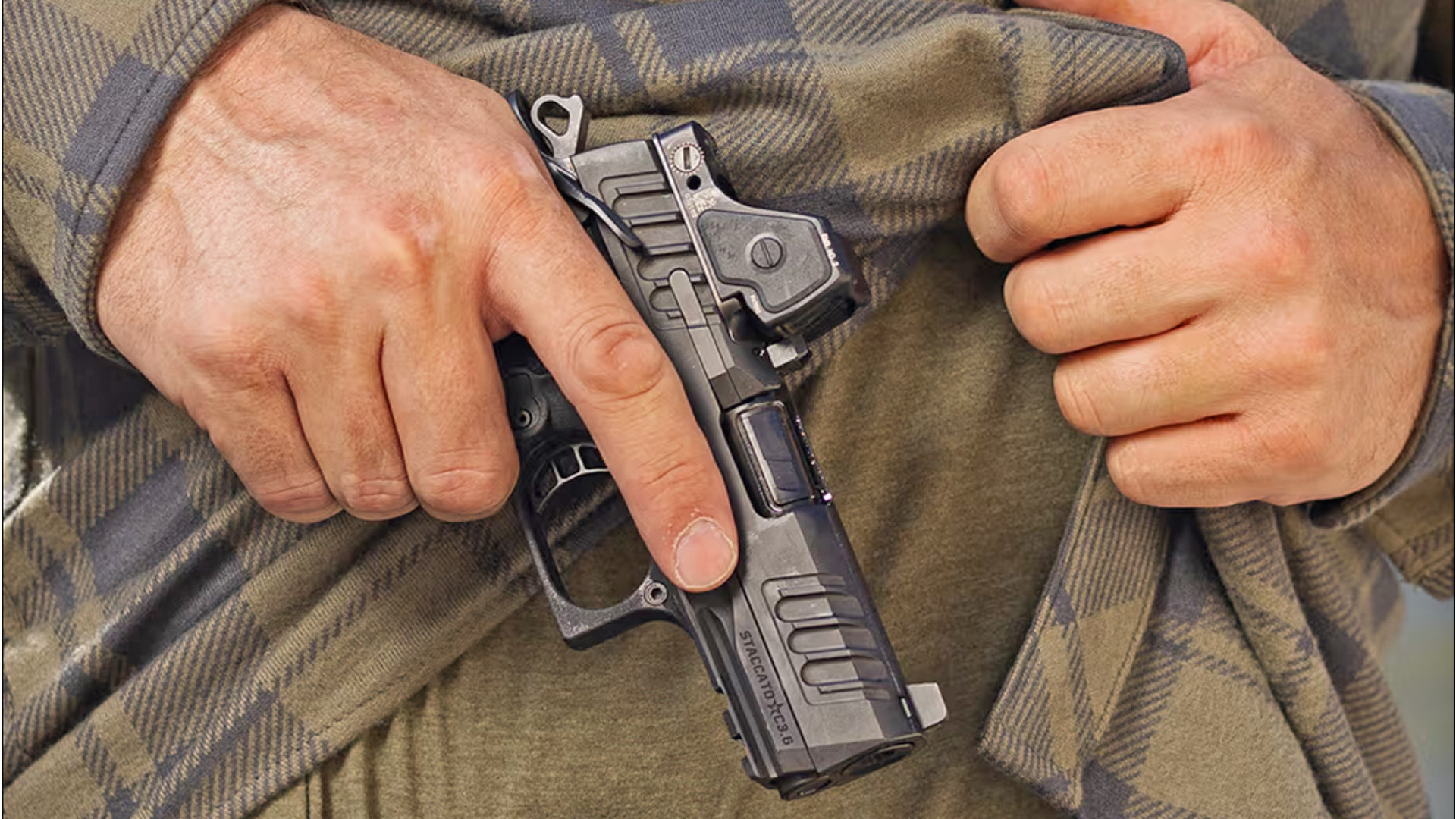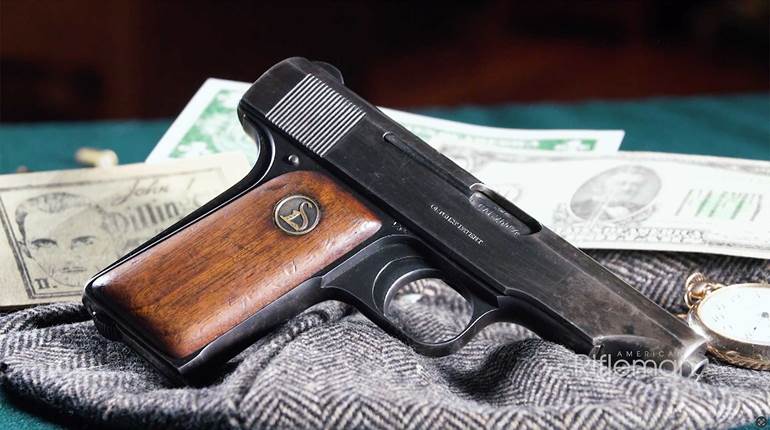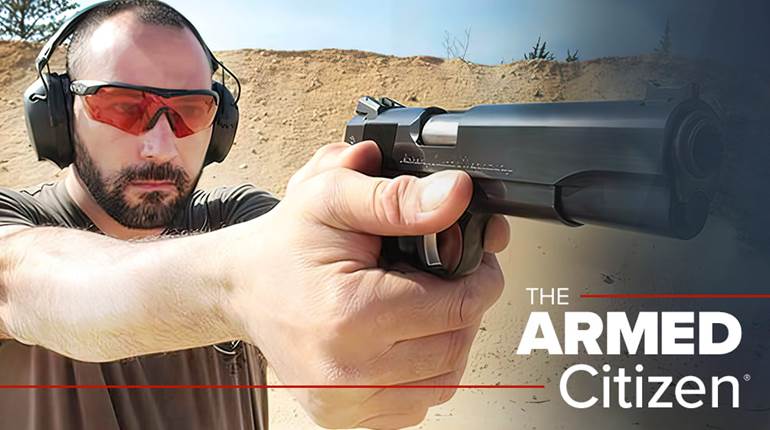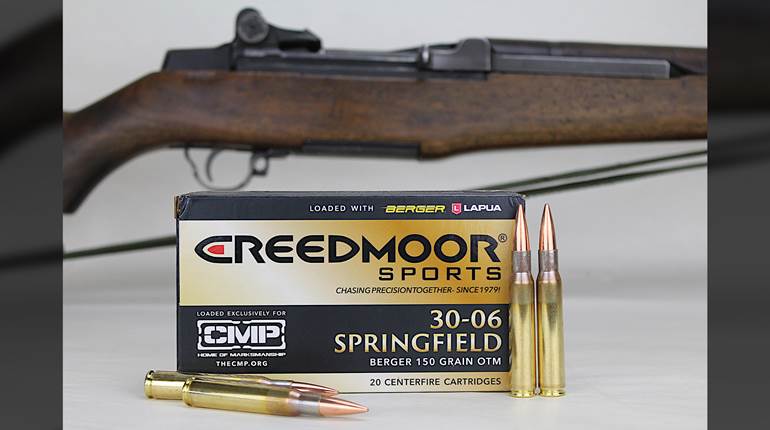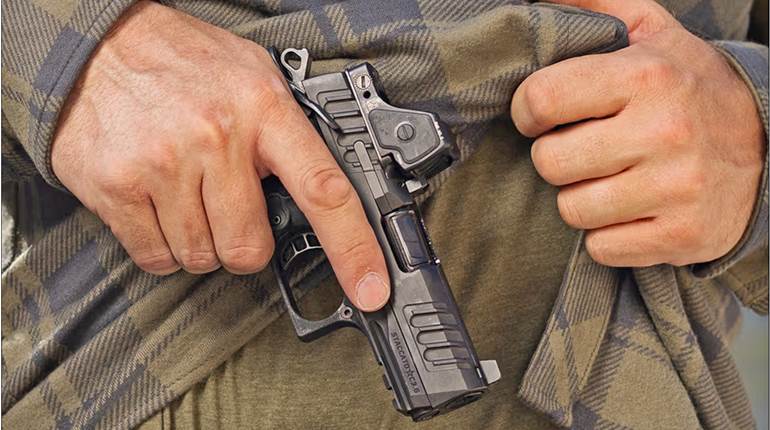
The Maschinengewehr 42, more commonly called the MG42, was Germany’s final development in its longstanding “universal machine gun” concept. It was also the beginning of a GI nightmare and a significant challenge to America’s machine gun design priorities.
For American combat troops, the MG42 was a deadly problem, from their first encounters with the gun in Tunisia to the last day of the war in Europe. While its predecessor, the MG34, cycled fast at about 900 rounds per minute, the MG42 fired even faster, averaging about 1,200 rounds per minute. The cartridges go off so fast that individual shots cannot be distinguished and bursts sound more like a zipper or tearing cloth. The audible effect was particularly intimidating, as the GIs knew there were more rounds than they could count coming their way.
 The quick-change barrel: to accommodate a cyclic rate of up to 1,500 rounds per minute, the MG42’s barrel could be changed quickly without special tools. Photo courtesy of Finnish Wartime Photographic Archive, SA-kuva.
The quick-change barrel: to accommodate a cyclic rate of up to 1,500 rounds per minute, the MG42’s barrel could be changed quickly without special tools. Photo courtesy of Finnish Wartime Photographic Archive, SA-kuva.
Back in March 2015, NRA Media Editorial Director Mark A. Keefe, IV, commented on the 1944 War Department Film Bulletin: “Automatic Weapons—American versus German.” The program presents itself as a training film of sorts, but as Mark points out: “it is more of a propaganda movie.” That is true, and the government film production crew did get a bit carried away with patriotic fervor at times. In their defense, it was a different era, and the mounting concerns among troops in the Mediterranean and European Theater of Operations warranted an explanation and some advanced training in German infantry weapons.
The film shows a replacement soldier during his first combat action, participating in an attack on a German position defended by an MG42. The following is a transcript of the narrator’s script related to the MG42.
“The next time you hear that might be your first time in combat—a new replacement in a battle wise line outfit. You’re in this man’s shoes…you’re ready but you’ve never faced enemy fire.
Listen to that! Fast! That thing sprays a lotta lead! And you’re scared because the German gun fires faster than anything you’ve run into before…so much faster than the slow, steady bark of American machine guns you heard all through training. And you can’t see them either, in combat they’re not sitting out in the open.
So, keep an eye on your squad leader. He’s a veteran, he’s tangled with these weapons before, and he’s going after this one, sending men around the flank. Now he’s establishing his base of fire. Nobody seems especially afraid of that gun. Nobody but the replacement, who can’t get over the fast burp of that German gun. Well, so it does have a high rate of fire—does that mean it is a better fighting weapon than ours?”
 The 25.5-lb. MG42 gave the German infantry a mobile base of firepower. Photo courtesy of National Archives and Records Administration, NARA.
The 25.5-lb. MG42 gave the German infantry a mobile base of firepower. Photo courtesy of National Archives and Records Administration, NARA.
To answer the question of whether the MG42 is a better weapon than those used by American troops, the film shows comparison shooting of German MGs versus American types and concludes with a statement about American machine gun doctrine: “That’s the choice we’ve made—more guns, which shoot slower, but more accurately.” And that’s when the script turns ridiculously overly dramatic:
“When you know the drawbacks of these enemy weapons and realize their bark is worse than their bite, you aren’t afraid of some unknown thing. Their automatic weapons may fire fast, but if you know your stuff, you can stop ‘em cold! Remember, their bark is worse than their bite.”
 MG42 gunners were coached to fire in short bursts, normally five to eight rounds per burst. Photo courtesy of the Polish National Archives.
MG42 gunners were coached to fire in short bursts, normally five to eight rounds per burst. Photo courtesy of the Polish National Archives.
I’m not a doctor, but I am quite sure that any machine gun’s bite is always worse than its bark. The MG42 didn’t just sound intimidating, "Hitler’s Buzz Saw" killed and wounded tens of thousands of Allied troops. Regardless of the dangers, the GIs developed ways to overcome the fast-firing German gun.
The GIs Speak Out On The MG42
In a U.S. intelligence document on “German MG Tactics” (produced in early 1944), American combat soldiers shared their thoughts on dealing with the MG42:
“It’s true that the Germans have a good machine gun,” a U.S. junior officer who fought in Sicily remarked recently, “but, like many other German weapons, it doesn’t live up to all the latrine rumors you hear. It doesn’t walk on its hind legs or jump through hoops or anything like that. It’s just a good, fast gun. I feel that the sooner our men understand how the Germans use it tactically, the more success we’ll have in combating it.”
 When used from the Lafette tripod and equipped with an optical sight, the MG42’s effective range extended to 3,800 yards. Photo courtesy of the Polish National Archives.
When used from the Lafette tripod and equipped with an optical sight, the MG42’s effective range extended to 3,800 yards. Photo courtesy of the Polish National Archives.
German machine-gun tactics figure prominently in the following comments by U.S. soldiers who have been up against the gun lately and who can speak with authority of the ways in winch it is employed.
“What impresses me especially is the way the Germans site their machine guns so as to deliver crossfire from opposite sides of a road. I see a good deal of this, because I’m a jeep driver. They generally try to site guns at narrow places, such as defiles and bridges.”
“German machine-gun fire is usually so low—often about a foot and a half above the ground, that we call it ‘grass cutting.’ The Germans know that U.S. soldiers don’t allow their wounded to lie around any longer than is necessary, and that a man who has a leg wound of some kind will probably need a helping hand to get him to safety. It’s fairly obvious that the Germans know the value of immobilizing as many men as possible at one time.”
 Operating from a well-sited position, the MG42 was a formidable defensive weapon. This example is seen on the island of Corfu during 1943. Photo courtesy of the Polish National Archives.
Operating from a well-sited position, the MG42 was a formidable defensive weapon. This example is seen on the island of Corfu during 1943. Photo courtesy of the Polish National Archives.
“Although the German machine gun is first-rate as to fire power, its dispersion is poor. One of my friends had so much confidence in his ability to get away from it that on one occasion, even though he had already received a number of shoulder wounds, he made a successful dash for safety, and then turned and got the machine gunner with rifle fire—three shots in the stomach.”
“The machine gunners lie in wait for us. They’re very patient. For example, they know that sooner or later we’re going to want a certain little piece of commanding ground, or some spot that offers unusually good defilade. They lie motionless — always well camouflaged — for as long as may be necessary, and then let us have it.”
“Their light machine-gun fire is harassing as hell, but I don’t think much of its accuracy. As to height, I’d say it averages about two feet above the ground—often enough to let you slither out of the dispersion area.”
 The GI hobgoblin: an MG42 at a captured German ordnance display in Normandy during July 1944. Photo courtesy of National Archives and Records Administration, NARA.
The GI hobgoblin: an MG42 at a captured German ordnance display in Normandy during July 1944. Photo courtesy of National Archives and Records Administration, NARA.
“Keep moving if you want to live!”
Coming from the 12th Army Group in Normandy, the following comments were published in the U.S. Army’s “Battle Experiences” in the late summer of 1944:
“Germans sometimes employ their machine guns in this way: One man will fire tracer ammunition high and wild, and at the same time another will lay down pretty effective fire with ball ammunition. They use the tracers to make you think their fire is wild, when it is not.”
One squad leader summed up the need to maintain aggressiveness in the attack, even when the ripping noise of the MG42 made the replacements want to freeze: “Keep moving if you want to live!”
 MG42 on a Lafette tripod, displayed in Normandy during the summer of 1944. Photo courtesy of author’s collection.
MG42 on a Lafette tripod, displayed in Normandy during the summer of 1944. Photo courtesy of author’s collection.
Accuracy is always important, but the German notion of suppressing fire that quickly doused an area in lead was an entirely valid counterpoint. The American method claimed victory, but there was a high price to pay.
Attention to Details
As the war progressed up the Italian peninsula, American troops found themselves facing the MG42 more and more. Consequently, U.S. Intelligence presented more information on the weapon (and its running mate, the MG34). In late August 1943, an issue of “Tactical and Technical Trends” presented additional, detailed information on the MG42:
Method of Operation
The principle of operation is a combination recoil and blow back. In place of the Solothurn rotating holt-head action of the MG 34, there is a new system. This involves a lateral separation of the bolt studs in the cylinder from the bolts in the barrel extension.
An improved feed mechanism is provided. Barrel changing is extremely rapid. No provision is made for firing single rounds.
 U.S. ordnance men testing an MG42 in Normandy, summer 1944. Photos courtesy of National Archives and Records Administration, NARA.
U.S. ordnance men testing an MG42 in Normandy, summer 1944. Photos courtesy of National Archives and Records Administration, NARA.
Construction
The extensive use of stamping, riveting, and spot welding gives the gun a less finished appearance than that of the MG 34. There are few machined parts. However, this does not mean that its life is shorter or its performance inferior.
Use of MG 34 and the MG 42 as light machine guns is comparable, except that, in the case of the newer model, the higher rate of fire and the consequent “creep” of the gun makes shorter bursts (of 5 to 7 rounds) advisable. Twenty-two aimed bursts can be fired in 1 minute.
Use As Heavy Machine Gun
The tripod has been slightly modified to suit the catches on the gun but has not been altered in essentials. A new and slightly modified telescopic sight is also in use.
 MG42 on a Lafette tripod, displayed in Normandy during the summer of 1944. Photo courtesy of author’s collection.
MG42 on a Lafette tripod, displayed in Normandy during the summer of 1944. Photo courtesy of author’s collection.
German manuals advise bursts of 5 rounds for best results.
As in the case of the MG 34, the barrel should be changed after 250 rounds of more or less continuous fire, although prisoners of war have stated that barrels need not be changed until 400 rounds have been fired. It has been suggested that the detachment may carry more than 3 spare barrels, but this point has not yet been established.
By this system, the gun attains a rate of fire of 1,100 to 1,350 rpm which would appear to be unnecessarily high for a ground gun, though of obvious value for AA fire; the cyclic rate of fire of the MG 34 is from 800 to 900 rpm. Preliminary trials show, however, that this high rate of fire has not been obtained without a certain decrease in accuracy compared with the MG 34.
 Men of the 34th Infantry Division examine a captured MG42. Italy, 1943. Photo courtesy of National Archives and Records Administration, NARA.
Men of the 34th Infantry Division examine a captured MG42. Italy, 1943. Photo courtesy of National Archives and Records Administration, NARA.
Barrel Changing
The frequent barrel changing necessitated by the high rate of fire is met by the introduction of a rapid and efficient barrel-changing device. A barrel change lever is hinged in the right side of the barrel casing and can be swung outward bringing with it the barrel, which lies in a metal loop attached to the inside of the change lever. The barrel can then be slid out to the rear.
Construction
The extensive use of pressing, riveting and spot-welding in the construction (there are very few machined parts) gives the gun a less finished appearance than is usual in German weapons. Considerable effort has been made to lighten the gun without the loss of strength—for example by making holes in the operating handle. There is no reason for assuming, however, that its life and performance are not up to the usual German standard.
 Shades of “Saving Private Ryan:” A GI questions a German about a recently captured MG42. Photo courtesy of National Archives and Records Administration, NARA.
Shades of “Saving Private Ryan:” A GI questions a German about a recently captured MG42. Photo courtesy of National Archives and Records Administration, NARA.
Ongoing Tests & Comparisons
U.S. Ordnance was greatly impressed with the MG42, with an ongoing series of tests and comparisons to the U.S. Browning M1917A1 and Browning M1919A4. The introduction of the report “Comparison of Flash & Smoke Produced by United States Army Ordnance and German Weapons” (April 1945) notes: “In some cases, the German weapons show less flash due to the use of flash hiders. Flash hiders are now being furnished for some American weapons but were not used in these tests. Developments already completed or in process will reduce further the flash of American weapons.”
The flash and smoke tests revealed a definite need for flash hiders on American machine guns, and this would take place, but for the most part only after the war. The following report documents the comparison of the flash using standard ball ammunition:
Cartridge, Ball, Cal. .30, M2, fired in the Browning Machine Gun, Cal. .30, M1917A1 produced a medium size orange flash larger than that of the M1919A4 machine gun. It was clearly discernible from 100 yards down range and dimly visible from 300 yards.
The German Machine Gun, 7.92mm, MG42, was fired with Cartridge, Ball, 7.92mm, MG42 for flash comparison with the American weapons. The very small orange flash from this gun was much smaller than the flash of either the M1919A4 or M1917A1 machine guns. It was dimly visible from 100 yards and could scarcely be detected from 300 yards.
 A captured hornet’s nest on the Gothic Line in Italy: GIs examine a pair of MG42s and a radio connection in a German machine gun nest. September 1944. Photo courtesy of National Archives and Records Administration, NARA.
A captured hornet’s nest on the Gothic Line in Italy: GIs examine a pair of MG42s and a radio connection in a German machine gun nest. September 1944. Photo courtesy of National Archives and Records Administration, NARA.
Recommendations For Change: “It can be said that the paper as a whole indicates trends of thought.”
The MG42 made a huge impression on American forces—from the combat GIs and their officers to even a few stateside observers looking at the weapons of war from a strategic level. On Jan. 28, 1945, the War Department Observers Board in Washington, D.C., received a report titled “Proposed Changes in Organization and Equipment” from Col. Albert G. Wing (Infantry Observer). The document contains many strong opinions based on interviews with GIs and in-the-field observations, and some of them were not particularly flattering to American weapons. The following is the portion of the report dealing with machine guns:
Machine Guns:
A
- The Browning .30 caliber machine gun is too expensive to manufacture.
- The head space adjustment and the changing of barrels requires too long. The barrel of the German machine gun can be changed in a fraction of the time.
- The rate of fire is far below that of the German gun, approximately half.
 A prized war trophy: A GI examines a Lafette tripod-mounted MG42 in France during the autumn of 1944. Photo courtesy of National Archives and Records Administration, NARA.
A prized war trophy: A GI examines a Lafette tripod-mounted MG42 in France during the autumn of 1944. Photo courtesy of National Archives and Records Administration, NARA.
B
- It is recommended that a new type machine gun be designed (based on the German machine gun if necessary) in which stampings will take the place of expensive machine parts, and in which head space adjustment will not be necessary. A gun patterned after the German machine gun is adaptable to mass production methods of manufacture and can be turned out at a fraction of the cost and in greater quantity.
- Consideration should be given to the design of a gun with an adjustable rate of fire, which can be varied between that of the Browning and of the German machine gun.
- The tripod mount of our present gun is superior to that of the German and some adaptation of it should be retained.
- Water cooling for the heavy machine gun should be retained.
Dodging a Bullet in the Pacific
The Allies weren’t the only combatant force impressed with the MG42. The Japanese military mission to Germany was initially interested in the MG34 but were denied a license to manufacture it. However, they were interested in the MG42 and were apparently close to making the gun for military use, but it never materialized. I found this mention of the MG42 in the U.S. Intelligence survey “German Technical Aid to Japan,” produced in September 1945:
7.92 mm MG-42: The Japanese Army was anxious to secure the manufacturing rights for this weapon early in 1943 and the German Army was willing to grant permission; there is no evidence, however, that a contract was ever signed. In June 1943, Army representatives in Berlin procured a general outline of German methods of manufacturing the MG-42 and it seems that at that time manufacture of the gun in Japan was contemplated.
 Weapons familiarization: GIs receive advanced training in comparative U.S. and German weapons. Two MG42s, an MG34 and an MP40 SMG are test fired alongside U.S. Browning M1919A4, M1917A1 and M2 machine guns. February 1945. Photo courtesy of National Archives and Records Administration, NARA.
Weapons familiarization: GIs receive advanced training in comparative U.S. and German weapons. Two MG42s, an MG34 and an MP40 SMG are test fired alongside U.S. Browning M1919A4, M1917A1 and M2 machine guns. February 1945. Photo courtesy of National Archives and Records Administration, NARA.
In a small miracle, American forces were spared the perils of facing the MG42 in the Pacific as well as in Europe. As World War II ended, the MG42 endured, eventually evolving into the West German MG3, the Swiss MG51 and the Yugoslavian M53, as well as providing significant influence in the design of the U.S. M60 and the NATO FN MAG, known in U.S. military service as the M240.
